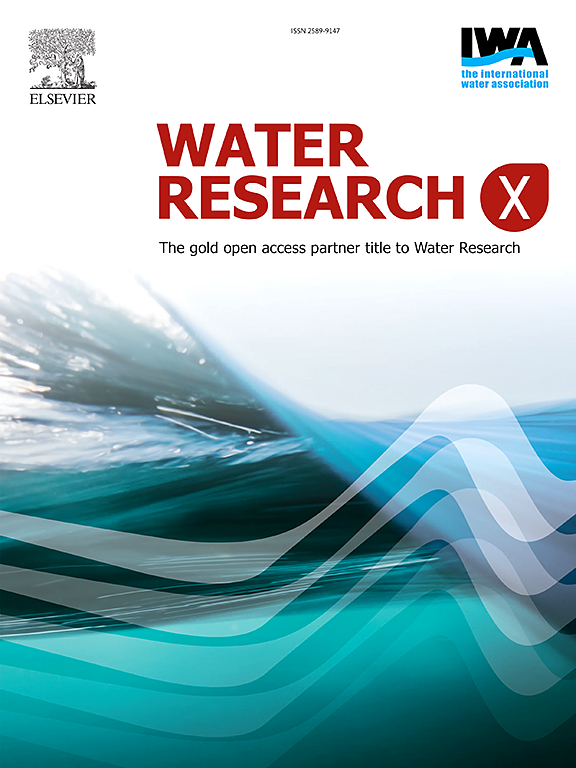Copper’s dual role in aerobic methane oxidation coupled with aerobic denitrification: Boosts CH4-derived carbon for denitrification but inhibits it via methanobactin competition
IF 8.2
2区 环境科学与生态学
Q1 ENGINEERING, ENVIRONMENTAL
引用次数: 0
Abstract
Aerobic methane oxidation coupled with aerobic denitrification (AME-AD) has the capability to remove nitrate and reduce methane (CH4) under aerobic conditions. However, the impact of copper as a cofactor in wastewater and its underlying mechanism in the AME-AD process remains unexplored. This study conducted a series of batch experiments, examining the influence of copper concentrations (ranging from 0 to 20 μM Cu2+) on denitrification, CH4 oxidation, nitrous oxide (N2O) generation, and the expressions of key functional genes within a synthetic AME-AD community. The results revealed that Cu2+ concentrations significantly affected the denitrification capacity of the AME-AD system. Specifically, the 10 μM Cu2+treatment exhibited optimal AME-AD performance, achieving a denitrification rate of 0.031 mg·h-1 and a CH4 oxidation efficiency of 98 %. However, this treatment had a high proportion of N2O generation (4.79 %), ultimately resulting in a decrease in the overall reduction of total greenhouse gases to 802.5 mg CO2-e. Moreover, the Cu2+ concentrations had a significant impact on the expression of crucial genes associated with aerobic denitrification (napA, nosZ) and CH4 oxidation (pmoA). Specifically, the highest abundance of functional genes related to denitrification was observed in 15 μM Cu2+ treatment, with napA reaching 3.75 × 1010 copies·g-1 and nosZ attaining 1.32 × 109 copies·g-1 at 192 h. Conversely, the peak pmoA copy number of 4.8 × 109 copies·g-1 was noted in 10 μM Cu2+ treatment. These discoveries enhance our comprehension of how copper modulates the AME-AD process and facilitate its application in treating low-C/N wastewater and mitigating greenhouse gas emissions.

铜在好氧甲烷氧化和好氧反硝化中的双重作用:促进ch4衍生碳的反硝化作用,但通过甲烷菌素的竞争抑制它
好氧甲烷氧化耦合好氧反硝化(AME-AD)在好氧条件下具有去除硝酸盐和还原甲烷(CH4)的能力。然而,铜作为辅助因子在废水中的影响及其在AME-AD过程中的潜在机制仍未被探索。本研究进行了一系列的批量实验,研究了铜浓度(0 ~ 20 μM Cu2+)对合成AME-AD菌群反硝化、CH4氧化、N2O生成以及关键功能基因表达的影响。结果表明,Cu2+浓度显著影响AME-AD系统的反硝化能力。其中,10 μM Cu2+处理表现出最佳的AME-AD性能,反硝化率为0.031 mg·h-1, CH4氧化效率为98%。然而,该处理具有较高的N2O生成比例(4.79%),最终导致温室气体总量减少到802.5 mg CO2-e。此外,Cu2+浓度对与好氧反硝化(napA, nosZ)和CH4氧化(pmoA)相关的关键基因的表达有显著影响。在15 μM Cu2+处理下,与反硝化相关的功能基因丰度最高,napA在192 h达到3.75 × 1010 copies·g-1, nosZ达到1.32 × 109 copies·g-1,而pmoA在10 μM Cu2+处理下的拷贝数最高,为4.8 × 109 copies·g-1。这些发现增强了我们对铜如何调节AME-AD过程的理解,并促进了其在处理低碳/氮废水和减少温室气体排放方面的应用。
本文章由计算机程序翻译,如有差异,请以英文原文为准。
求助全文
约1分钟内获得全文
求助全文
来源期刊

Water Research X
Environmental Science-Water Science and Technology
CiteScore
12.30
自引率
1.30%
发文量
19
期刊介绍:
Water Research X is a sister journal of Water Research, which follows a Gold Open Access model. It focuses on publishing concise, letter-style research papers, visionary perspectives and editorials, as well as mini-reviews on emerging topics. The Journal invites contributions from researchers worldwide on various aspects of the science and technology related to the human impact on the water cycle, water quality, and its global management.
 求助内容:
求助内容: 应助结果提醒方式:
应助结果提醒方式:


